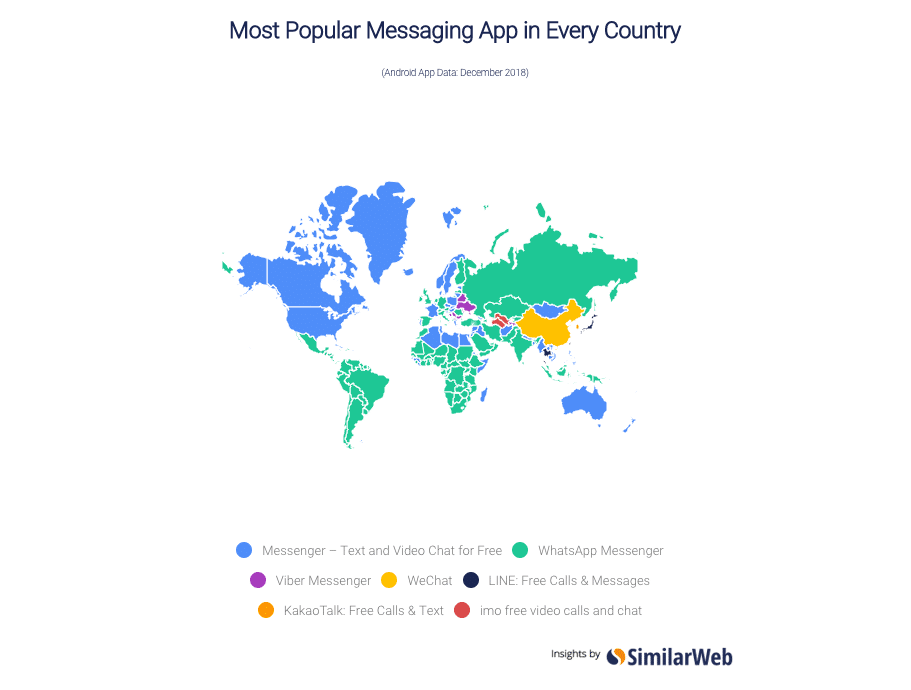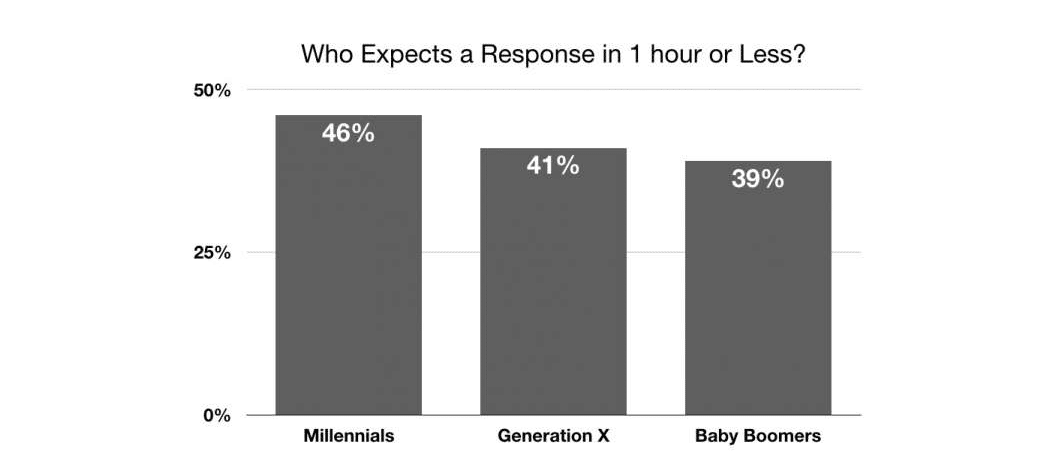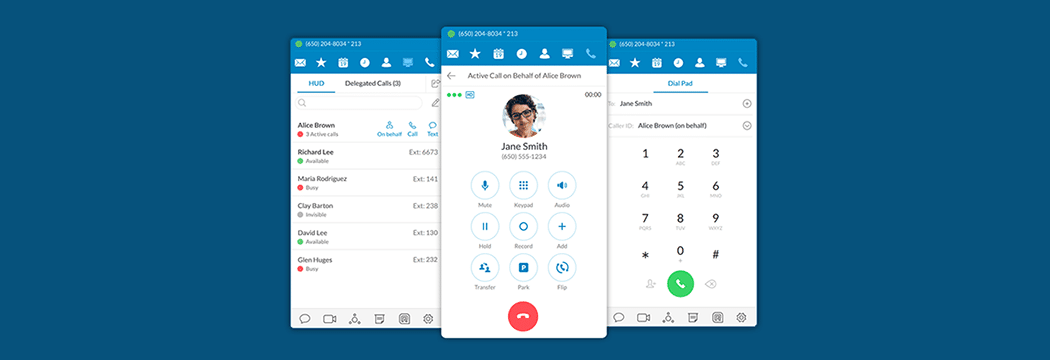For customers, messaging can be beneficial to engage with your digital and customer engagement strategy. So doing it correctly is paramount. In a recent survey, 67% of people said they expect to use messaging apps to talk to businesses, which is why you should consider it as a point of contact.
The benefits of messaging include; privacy, an alternative to live chat, plus a number of functions such as new message notifications, “message read” statuses, images, and geolocation.
Adding messaging improves customer care by simplifying exchanges, sharing sensitive information securely, integrating into the customer care ecosystem, and giving off an innovative image of your company.
With new channels such as Apple Business Chat and WhatsApp Business Solution, the trend of Messaging for customer service is set to increase even further. Gartner predicts that customer service enquiries through messaging apps will surpass the ones on social media this year. So if you have already adopted messaging or consider doing so, read our 10 customer service tips to provide the right experience.
Aligning your brand
1. Be where your customer is
If your brand is popular amongst a certain demographic, being available on the relevant channels for them can help fit your image. More companies are adopting an Omni-Digital approach, meaning they use digital channels for customer service. Among them, messaging is one of the most popular channels, especially among younger generations: 91% of teens use messaging apps every day.
According to Inc.com; “Seven out of 10 of the 18 to 34-year-olds surveyed said they could imagine a world in which there is no longer any such thing as brick and mortar stores, and all purchases would be made digitally or online.”. This finding also shows the new Omni-Digital habits and expectations of this customer group.
It can be challenging to be wherever your customers are, but being available on messaging channels can go a long way to improving their experience for a start.
Another factor to consider is the users’ preferences based on demographics. If you operate in several countries, you should make sure to be present on the most popular messaging apps. For example, a company wishing to adopt messaging should prioritize Messenger for North America while it should be WhatsApp in South America.

2. Match the tone and language of your brand
Tone and language are important for your audience to identify your message and brand. It should fit with the type of company you are and/or the product you sell. They should see that you matched one to the other, it should be clear to them and recognizable.
For example, If you are a luxury suit wear brand targeting professionals, you are unlikely to use GIFs, emojis, and pop-culture references that are informal to your customers. Align the values of your company with your customers.
Your brand message plays a critical role in driving value and essence. Having a strong tone and aligning your messaging will bring clarity and consistency.
While keeping this in mind, you should adapt your way to communicate to the right format and tone of messaging. The way to talk via this channel is different than emails. Don’t use a too formal tone and very long messages, and take advantage of rich features (images, localization, etc…)
Customer Engagement Strategy
3. Designing your experience
When adopting messaging, you have to offer customers the right experience. By using Messenger or WhatsApp, customers expect to get the same experience as when communicating with their friends and family. That is why your processes should be adapted to the specificities of this mean of communication, without redirecting to other channels like email for example. Also, your agents should be trained on the way to communicate via messaging.
Make sure you retain customers attention, keeping an eye on messages as they receive them. Segment the information you send customers, keep it short and concise.
Consider when your messages appear to customers. Don’t bombard them with messages just as they open the app, as it may push them away. Design this engagement accordingly.

4. Consider the adoption of In-App Messaging
Customers want the quickest and most effective resolution possible. By using in-app messaging, customers can send their enquiry directly within the app and you can respond.
With in-app messages you are already at a certain advantage – the messages are visible only when one is using an app. Users are already engaged in your app and not a third party one, which may offer you a chance to succeed in resolving the issue.
Unlike external messaging apps, in-app allows you to own the data and control the features. Integration of the customer’s account is also secured so his information can be accessed easily, without the agent needing to switch between apps or browsers.
Also, incorporating in-app messaging allows to increase the app’s stickiness: thanks to this feature, customers will have more reasons to keep your app installed and use it. This is an opportunity to communicate about your promotions or custom offers. Of course, these notifications should not be used to override the user’s request to turn off push notifications but instead for offering a feedback survey or discount code. It can also help support an Omni-Digital customer experience strategy.
5. Monitor the results to make sure the experience is good
Just like any channel, you should monitor certain KPIs to ensure the experience offered meets your customers’ expectations. You can track KPIs such as:
- Average handle time to make sure customers get answers in a timing adapted to messaging
- Customer satisfaction with short and simple surveys to get their feedback
- Volumes of messages per day and times of the day to anticipate peaks and staff team accordingly (hello, customer service teamwork)
If you detect issues, you should take actions to fix them. This can be done by training agents, improving processes or tools such as a knowledge base and spell checking to ease the work of agents and improve your response time.
Integration and availability
6. Meet the customers’ Response Time expectation on Messaging
Each app has its own definition of effective response time such as Facebook. We suggest that you prioritize a reactive conversation starter. Ideally, customer waiting times should be limited to around 2–3 hours. A study revealed that response time for companies should be within an hour, with 15 minutes being the target for World Class service.
Messaging apps are encouraging companies to meet these expectations: on Messenger, a badge “Very responsive to messages” is displayed on pages achieving both 90% or more response rate and a response time of less than 15 minutes. On WhatsApp, companies have 24 hours to answer free of charge. After this timeframe, they will be charged.
Consumers expect quick answers, meaning companies need to improve their response time promise. One of the ways to achieve it is to rely on a tool unifying the management of all messaging channels. Also, a bot that is properly designed will suit basic requests and be able to respond with answers all the time.

Source: MyCustomer
7. Showcase your presence
Adopting messaging is a great way to meet your customers’ expectations and allow them to contact you with apps they use daily. However, if you want them to use it, you have to communicate about your presence. You have to think of the customer journey and where messaging would be relevant. One of the first steps is to make it appear on your Contact page, where customers are most likely to go.
Each messaging channel has its specificities to showcase your presence:
- Messenger: the conversation can be started from Facebook pages and “Message Us” buttons that can be integrated into Facebook posts or websites.
- Apple Business Chat: conversations can be initiated from Apple apps such as Safari, Spotlight, Maps… Companies can also implement “Chat with Messages” buttons on their websites, redirecting users into Messages app.
- WhatsApp Business Solution: companies can use buttons and short links in the format “wa.me” for users to launch a conversation in the app.
- Messaging In-App: as the feature is integrated into the company’s app, it is possible to control how the conversation is initiated: from a click in the menu, with a popup or on specific pages.

8. Use a tool integrating all messaging features
When talking on a digital channel, agents should have the same type of interface as customers. To make interactions more relevant, agents should have access to the channel’s native features. For messaging, it means being able to see everything sent by customers, such as images, emoji, attachment…
Agents should also be able to send these types of content to assist customers efficiently. That way, the company avoids redirecting to other channels, for example, email to send an attachment.
If your agents are using multiple messaging channels to handle customer’s queries, then the use of an Omni-Digital platform can help unify their management while integrating all native features. In addition to this, you will be able to access a unified conversation history across channels.
Correctly managing Ai and automation
9. Dedicate chatbots to specific issues
Messaging is one of the main channels for chatbots. When implementing it, companies should be aware of the technology’s limits. To provide an optimal customer experience, it is better to limit the perimeter of chatbots to specific issues. That way, you will make sure it is very good at answering questions it has been designed for, without disappointing customers. Depending on the situation, customers may prefer interacting with a chatbot or a human.
A study found that most people prefer chatbots when they’re checking an order status or doing product research. When it comes to customer service inquiries or making a reservation, customers prefer humans over chatbots.
10. Setup a handover between your chatbot and agents
One myth you should be familiar with is that chatbots know everything, which they don’t. A chatbot is only as good as its design and that depends on the capabilities of its AI and NLP.
Having a human agent collaborate with chatbots can ease the fear that your customer will be left waiting without answers. There are triggers to allow this handover and doing so can make your chatbot more effective.
Conclusion
If you apply all these tips, it can be useful and resourceful for companies who will or have already adopted messaging. There are multiple benefits to using messaging in your customer care strategy and many ways you can improve the experience for your agents. When using such integrations as Apple Business Chat, WhatsApp for Business, and Messenger for Business, it is essential to adopt an omni-digital solution to process interactions efficiently.
Originally published Feb 07, 2019, updated Dec 30, 2022







